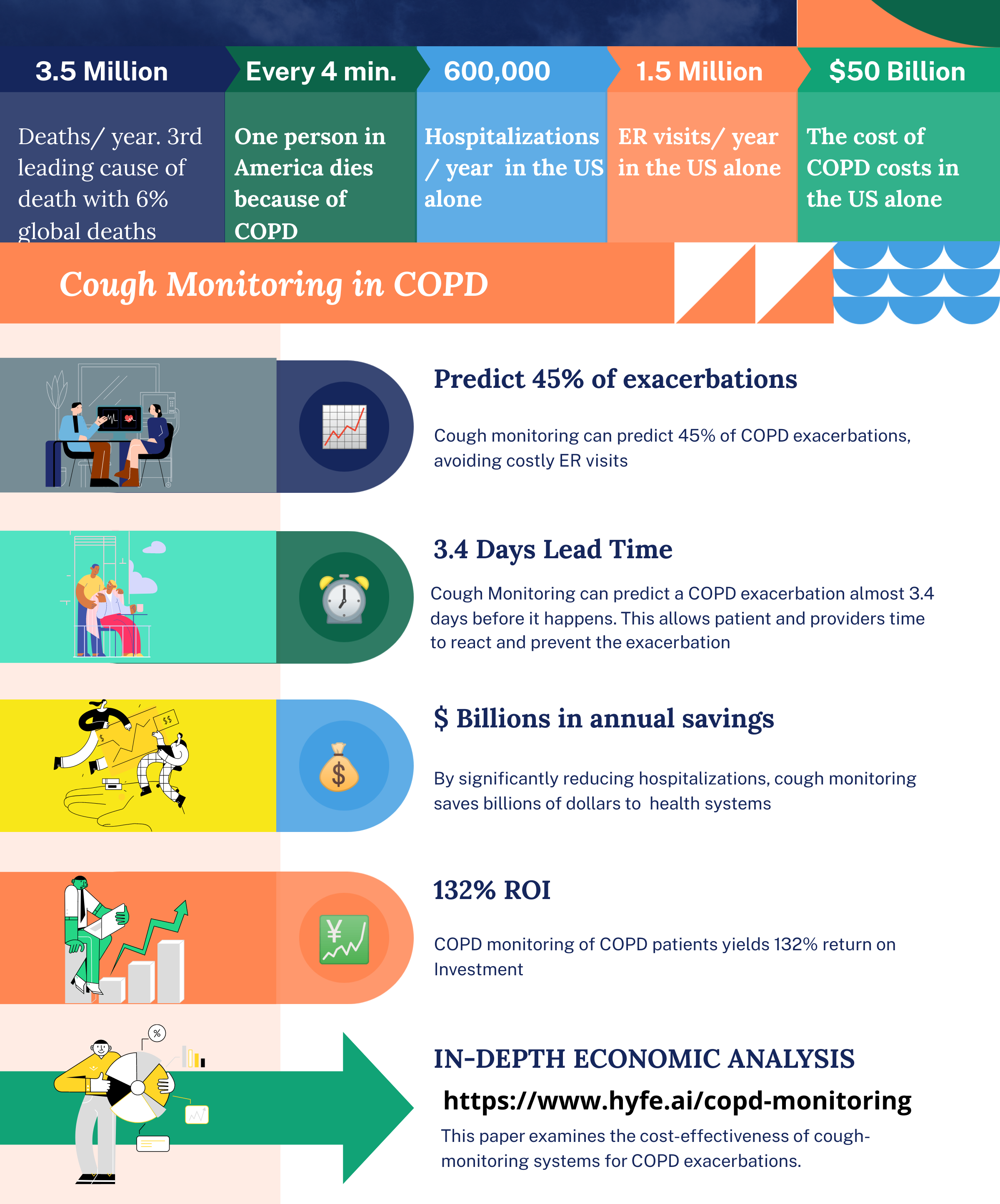Chronic Obstructive Pulmonary Disease (COPD) incurs billions in medical expenditures annually, with acute exacerbations and subsequent hospitalizations being significant cost drivers. At-home cough-monitoring is a promising innovation with the potential to reshape this landscape.
This analysis examines the cost-effectiveness of cough-monitoring systems for early detection of COPD exacerbations. The findings are:
This comprehensive paper provides an overview of the costs and benefits of COPD monitoring, including a cost-benefit analysis. The paper also discusses the potential for cost savings by using a-home COPD monitoring to prevent or reduce the severity of an exacerbation.
The paper calculates the cost-benefit analysis of implementing a cough-monitoring system for COPD, considering direct costs and the probability of correctly predicting exacerbations. It excludes non-financial benefits and indirect health outcomes.
Analysis reveals significant savings from timely interventioin and prevented hospitalizations. Sensitivity analysis shows the program remains highly profitable even with variations in detection rates, costs of care, and prevention rates.
Cough-monitoring for COPD is very cost-effective, offering substantial economic returns and potential benefits in preventing readmissions and improving patient quality of life.
Sources: COPD Statistics & Facts in the US (2023); COPD Trends Brief - Burden | American Lung Association; COPD Costs (cdc.gov)


Chronic obstructive pulmonary disease, or COPD, makes breathing difficult for the 16 million Americans who suffer from it. In addition to the high prevalence, COPD has no cure, and the high rate of hospital admissions (and re-admissions) associated with the condition have an estimated cost of more than $50 billion annually in the US alone. Out of this, more than $13 billion are direct medical costs.
It is essential to identify acute COPD exacerbations early or prior to their occurrence to improve the wellbeing of those living with COPD and reduce the economic costs of re/admissions. COPD remote patient monitoring uses technology to monitor a patient’s health outside of a traditional healthcare setting. COPD remote patient monitoring has the potential to keep high-risk patients healthy while minimizing unnecessary procedures and costs associated with in-patient care and monitoring.
The key symptom in effective COPD remote patient monitoring is cough. In addition to being one of the first signs of COPD, an increase in cough rate is a telltale early sign of an acute COPD exacerbation. Until recently, unlike temperature, blood pressure, pulse, etc. cough was not objectively measured or quantified, even for patients with conditions where cough is an extremely important indicator health. However, that has changed. Recent advances in wearable technology and AI have made automated cough detection and symptom quantification possible.

Cough monitoring can identify an acute COPD exacerbation 3.4 days ahead of time by noting an increase in cough frequency above a patient's individual baseline. An alert can be made to a healthcare provider, who can provide preventative care. The substantial lead time increases the chances the exacerbation can be avoided altogether. This means better health outcomes for patients, but also fewer hospital admissions and emergency room visits, better and more equitable accessibility to preventive care, more targeted interventions, and significantly lower overall health system costs.
Hyfe (www.hyfe.ai) builds software that detects coughing via audio analysis on phones, watches, wearables, and other devices with mics. Cough detection is fully automated, using AI algorithms trained on the sounds of coughs of tens of thousands of individuals. Since the system runs fully on-device, no audio data is sent to servers, thereby ensuring full patient privacy. By using Hyfe’s technology to detect and quantify cough, healthcare organizations seeking to roll out or improve COPD remote patient monitoring can improve outcomes and cut costs.